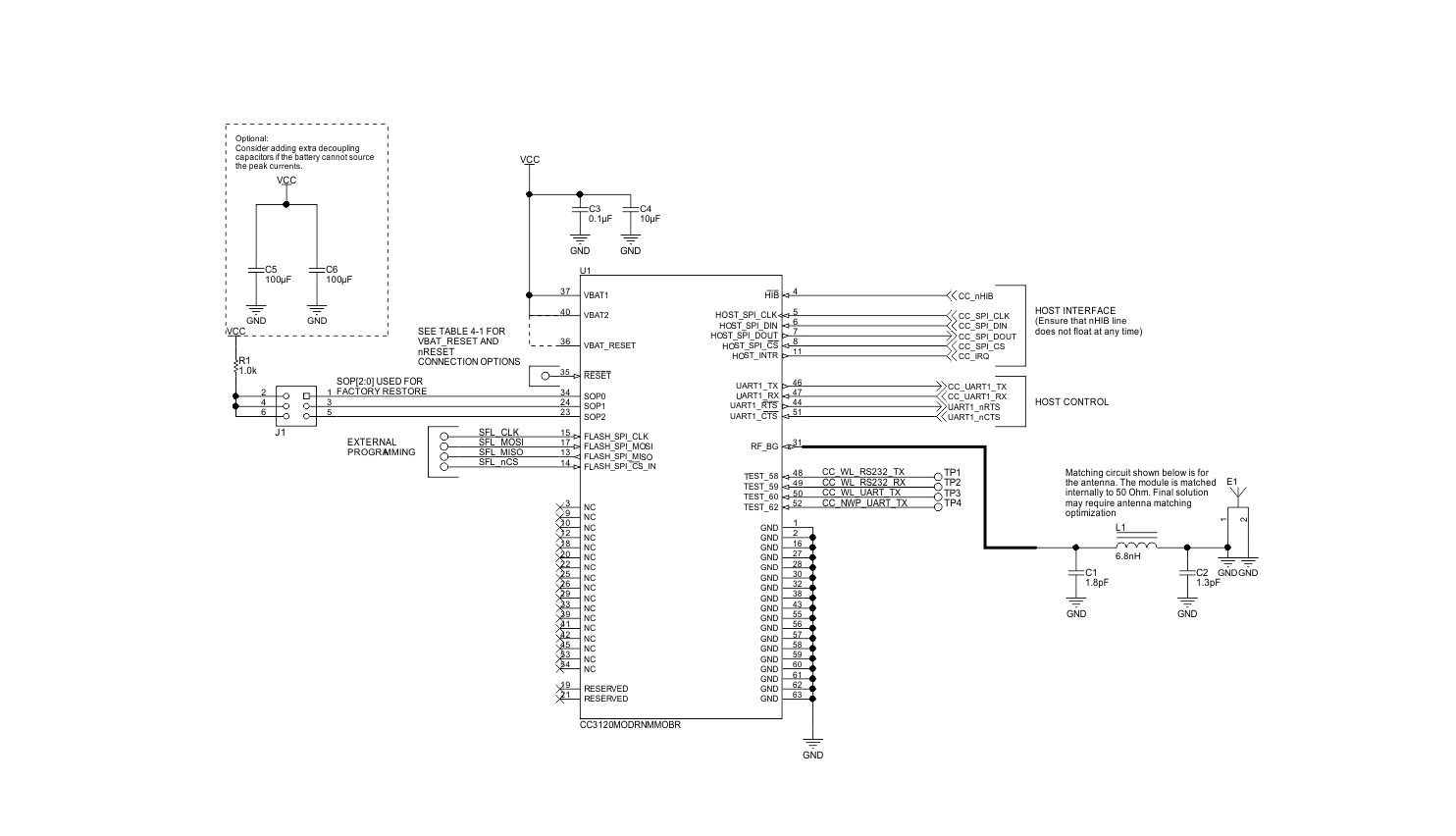SWRS205E March 2017 – May 2021 CC3120MOD
PRODUCTION DATA
- 1 Features
- 2 Applications
- 3 Description
- 4 Functional Block Diagrams
- 5 Revision History
- 6 Device Comparison
- 7 Terminal Configuration and Functions
-
8 Specifications
- 8.1 Absolute Maximum Ratings
- 8.2 ESD Ratings
- 8.3 Recommended Operating Conditions
- 8.4 Current Consumption Summary
- 8.5 TX Power and IBAT versus TX Power Level Settings
- 8.6 Brownout and Blackout Conditions
- 8.7 Electrical Characteristics
- 8.8 WLAN Receiver Characteristics
- 8.9 WLAN Transmitter Characteristics
- 8.10 Reset Requirement
- 8.11 Thermal Resistance Characteristics for MOB Package
- 8.12 Timing and Switching Characteristics
- 8.13 External Interfaces
- 9 Detailed Description
- 10Applications, Implementation, and Layout
- 11Environmental Requirements and Specifications
- 12Device and Documentation Support
- 13Mechanical, Packaging, and Orderable Information
10.1.1 Typical Application
Figure 10-1 shows the typical application schematic using the CC3120MOD module. For a full operation reference design, see the BoosterPack that uses the CC3120MOD module.

This is the
reference schematic and not an actual board design. For the board files and BOM,
refer to the CC3120MODBOOST in the CC3120MOD Tools Folder.
Figure 10-1 CC3120MOD Module Reference
SchematicTable 10-1 lists the bill of materials for a typical application using the CC3120MOD module shown in Figure 10-1.
Table 10-1 Bill of Materials
| QUANTITY | DESIGNATOR | VALUE | MANUFACTURER | PART NUMBER | DESCRIPTION |
|---|---|---|---|---|---|
| 1 | C1 | 1.8 pF | MuRata | GCM1555C1H1R8BA16 | CAP, CERM, 1.8 pF, 50 V, ±0.1 pF, C0G/NP0, 0402 |
| 1 | C2 | 1.3 pF | MuRata | GCM1555C1H1R3BA16 | CAP, CERM, 1.3 pF, 50 V, ±5%, C0G/NP0, 0402 |
| 1 | C3 | 0.1 µF | MuRata | GRM155R60J104KA01D | CAP, CERM, 0.1 µF, 6.3 V, ±10%, X5R, 0402 |
| 1 | C4 | 10 µF | MuRata | GRM21BR61A106KE19L | CAP, CERM, 10 µF, 10 V, ±10%, X5R, 0805 |
| 2 | C5, C6 | 100 µF | MuRata | GRM31CR60J107ME39L | CAP, CERM, 100 µF, 6.3 V, ±20%, X5R, 1206 |
| 1 | E1 | 2.45-GHz Ant | Taiyo Yuden | AH316M245001-T | ANT BLUETOOTH W-LAN ZIGBEE WIMAX, SMD |
| 1 | L1 | 6.8 nH | MuRata | LQP15MN6N8B02 | 6.8 nH Unshielded Thin Film Inductor 130 mA 900 mΩ Max 0402 |
| 1 | R1 | 1.0 k | Vishay-Dale | CRCW04021K00JNED | RES, 1.0 k, 5%, 0.063 W, 0402 |
| 1 | U1 | CC3120MOD | Texas Instruments | CC3120MODRNMMOBR | SimpleLink Certified Wi-Fi Network Processor Internet-of-Things Module Solution for MCU Applications, MOB0063A (SIP MODULE-63) |